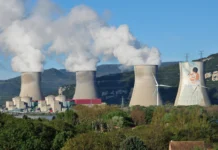
Smoke from Canadian wildfires was still affecting many areas of the Eastern US on Friday 9 June (as indicated by the many red areas on the government’s Fire and Smoke map), although this appeared to have subsided from an apparent peak on Wednesday, during which New York city was ranked as having the worst air quality in the world by IQAir’s World Air Quality Index (AQI).
IQAir’s index aims to provide a globally consistent metric, and so differs from the generic Air Quality Index (AQI) figures also often quoted in media coverage, whose calculation method varies from country to country. The US EPA’s AQI figure (from which the colour codes on the map linked above are derived), hit a peak of 484 at 5pm on Wednesday, according to Mayor Eric Adams (as noted by CNN) well into the level considered “hazardous”.
New York residents began smelling smoke on Tuesday evening (reported The Guardian) and air quality alerts were triggered on Wednesday. PM2.5 and PM10 particulate matter is a particular concern with this kind of pollution, although the smoke would be expected to include other toxic pollutants including carbon monoxide, VOCs, nitrogen oxides, and polycyclic aromatic hydrocarbons (PAHs).
Both the alert system used by the EPA and the IQAir index report on the five major pollutants also flagged in the US Clean Air Act: particulate matter, ozone, sulphur dioxide, carbon monoxide and nitrogen dioxide.
Alerts have been issued by at least 13 states, affecting cities including Washington DC, Detroit and Philadelphia.
While the wildfires have been centred mostly in the eastern province of Quebec, more than 400 fires were burning across the entire breadth of Canada on 9 June, with 232 deemed “out of control”, according to the map provided by the Canadian Interagency Forest Fire Centre. The smoke in New York was believed to be from fires in the east of Canada, and some of these had begun only days before the first signs of smoke appeared in the city (in the account provided by NewScientist), although the fires in western Canada have been underway for weeks. The smoke’s southward journey was blamed on a storm system that had appeared on the Atlantic coast.
Health authorities in areas issuing alerts were advising people to remain indoors, or not go outside unless they had to. N95 masks are also believed to offer protection from particulate matter pollution, and on Wednesday New York governor Kathy Hochul pledged to provide one million of these to residents. And for smaller rooms, air purifiers can be used to reduce indoor air pollution levels.







